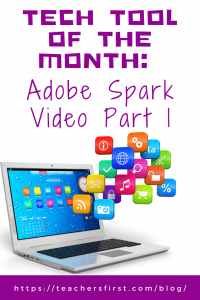Adobe Spark Video is a part of the Adobe suite. Create beautiful and brilliant videos in a few minutes. You can begin by using a template or start from scratch. There are prompts to follow as you begin to create and add slides, text, videos, photos, music, and more. Adobe Spark Video has over 1 million images to use (or you can add your own). Select the soundtrack that you like the best, and Spark will add the cinematic motion to your story. You have options for the font, theme, and many other components of the story. Create however many slides you wish to include and click play! When finished, you can publish and share it on social media or save it to your device. Adobe Spark Video allows you to create a professional-looking video with no design experience needed!
Applying the Triple E Framework
The Triple E Framework, created by Dr. Liz Kolb, is built on the belief that “effective technology integration begins with good instructional strategies and not fancy tools.” Dr. Kolb wrote a book on the topic: Learning First, Technology Second. Technology can be used to Engage in learning goals, Enhance learning goals, or Extend learning goals. We can use this framework to decipher why we are using specific tools in the classroom. Here is a rubric we can use to evaluate Adobe Spark Video (and any others) using the Triple E Framework. Use the rubric as you decide if a tool is a good fit with your learning goals and why you should (or shouldn’t) use the technology tool in the lesson.
 Engage in learning goals: The students are more focused on the task because Spark Video is allowing them to easily create videos that represent the content learning goals (for example, sharing a video related to an invention of the inventor). The students are more focused on the task because they are working at their own pace and creating the video. The students are more motivated to begin the learning process since they get to make decisions and are actively involved in choosing what to include in the video. There are no games, badges, or extras to distract from the process of learning.
Engage in learning goals: The students are more focused on the task because Spark Video is allowing them to easily create videos that represent the content learning goals (for example, sharing a video related to an invention of the inventor). The students are more focused on the task because they are working at their own pace and creating the video. The students are more motivated to begin the learning process since they get to make decisions and are actively involved in choosing what to include in the video. There are no games, badges, or extras to distract from the process of learning.- Enhance learning goals: By using Adobe Spark Video to create videos, students are able to share concepts, questions, and information. Videos allow students to assess their comprehension and to demonstrate a more sophisticated understanding of the topic by creating their own original work. Videos allow students to use technology to make connections to understand concepts and ideas. Students are using higher-order thinking skills to organize their thoughts and words for the video. Creativity is also included as they have the option to add sounds, text, videos, voice narration, and more.
- Extend learning goals: Dr. Kolb describes extended learning as an opportunity for students to learn outside of their typical school day, connect and collaborate outside of the regular school day, and as a bridge between the school day and real-life experiences. Completing (and sharing) Spark videos outside of the classroom would fit in with flipped or blended learning. Students could also work collaboratively in class, working in small groups would be a very purposeful choice, as fewer devices would be required, and students could help each other through the steps of the assignment. We are preparing our students for a world that doesn’t exist yet; however, most jobs do require independent motivation and knowledge of technology. Adobe Spark Video requires students to organize their thoughts and to create a purposeful video presentation related to the content. In future classes (and jobs), students are also likely going to need to be able to organize their thoughts and steps required to complete projects.
SAMR Connection
The SAMR Model, by Dr. Ruben Puentedura, suggests that technology implementation has four levels. We can use this model as a guideline to analyze how we are incorporating technology tools in the classroom. Adobe Spark Video fits at both the levels of Modification and Redefinition.
- Modification: The level of modification allows us to make the activity something more integrated with technology, meaning the activity could not even be done without technology. Adobe Spark Video offers students an option to share their understanding by creating a video. This could not be done without technology.
- Redefinition: The highest level of SAMR could be reached by sharing students’ final projects and offering feedback to others. Students could also add voice narration to the video and other multi-media to redefine the final project. Once the videos are created, have individuals (or cooperative learning groups) share the URLs to their videos with the class. The teacher could also share the videos on the class website for students (and families) to view.
Don’t miss Part 2 of the Tech Tool of the Month: Adobe Spark Video. We will discuss how to use the tool and provide classroom use ideas. In the meantime, let us know in the comment section below how you have used Adobe Spark Video in your education setting.


One thought on “Tech Tool of the Month: Adobe Spark Video Part 1”